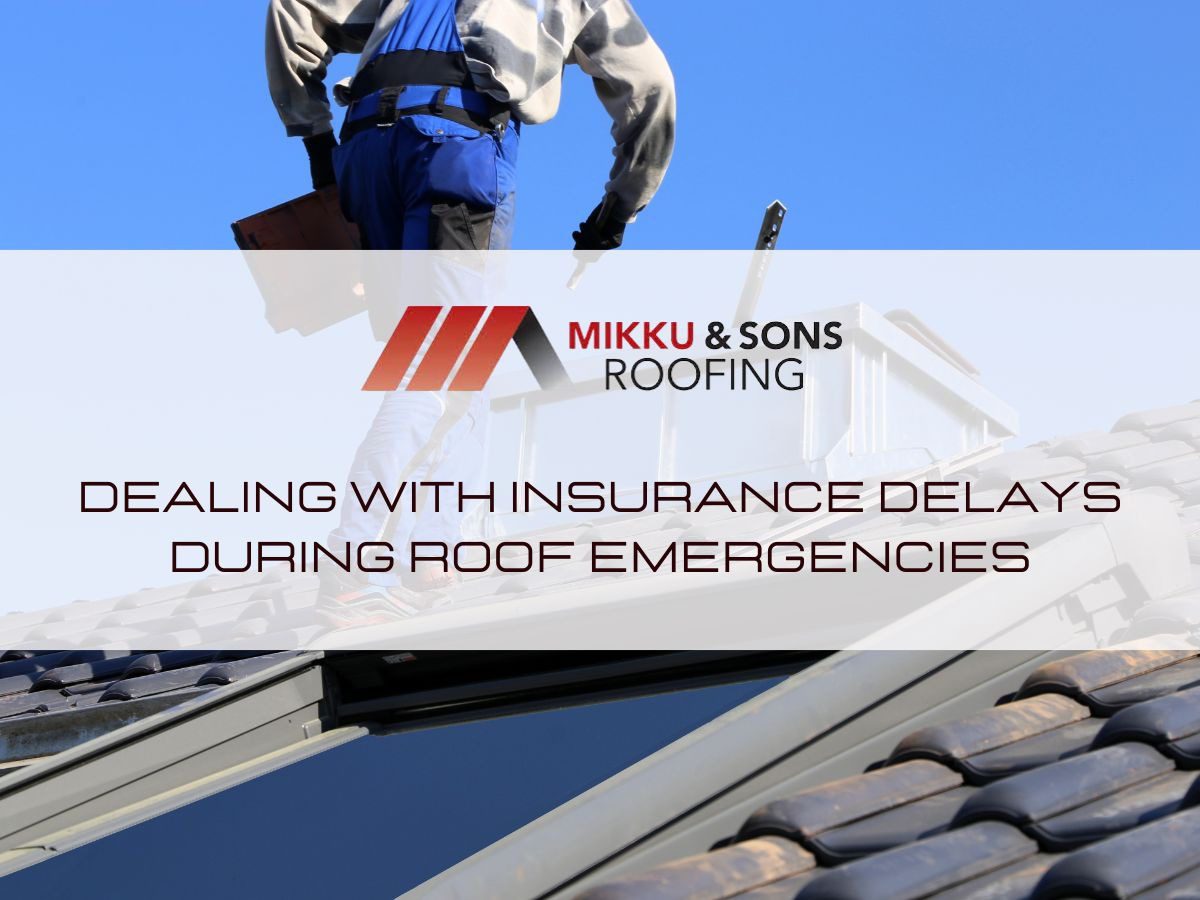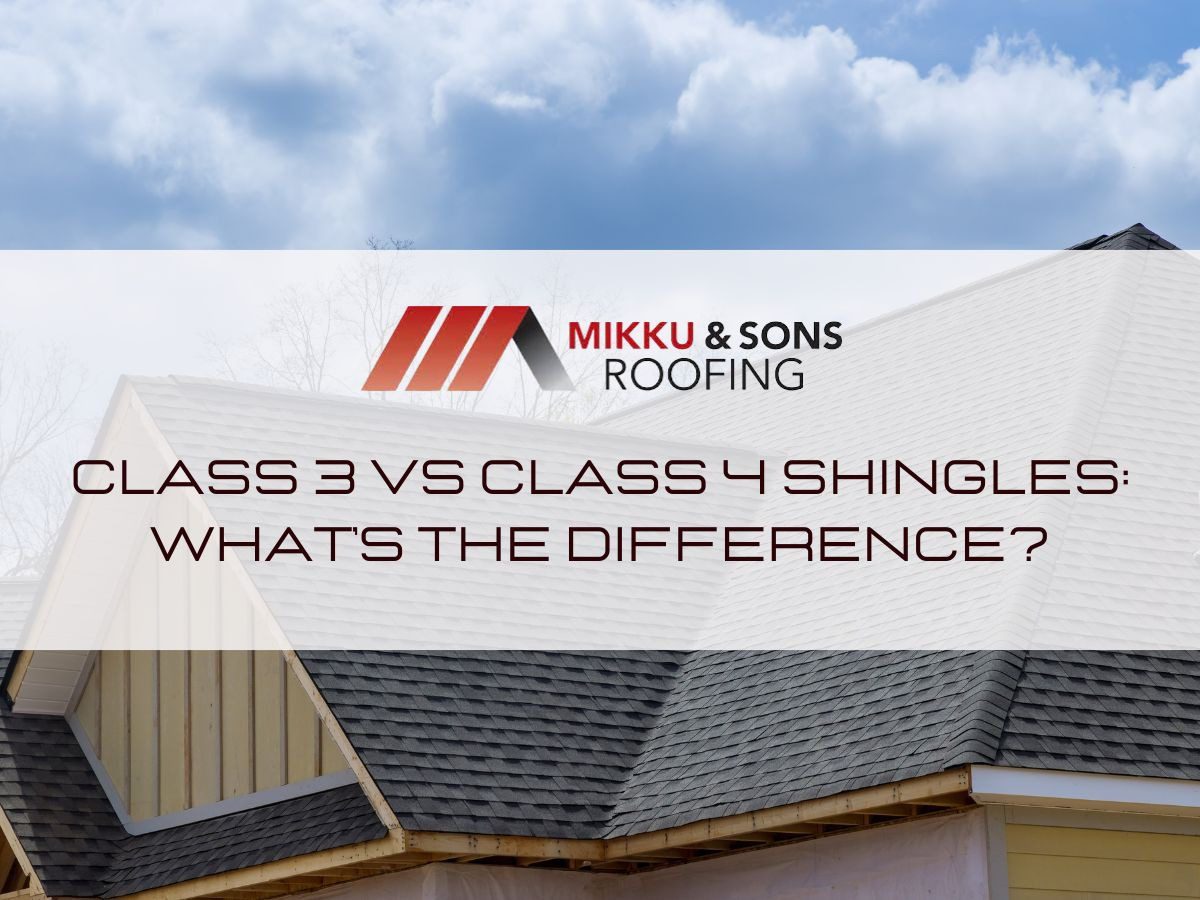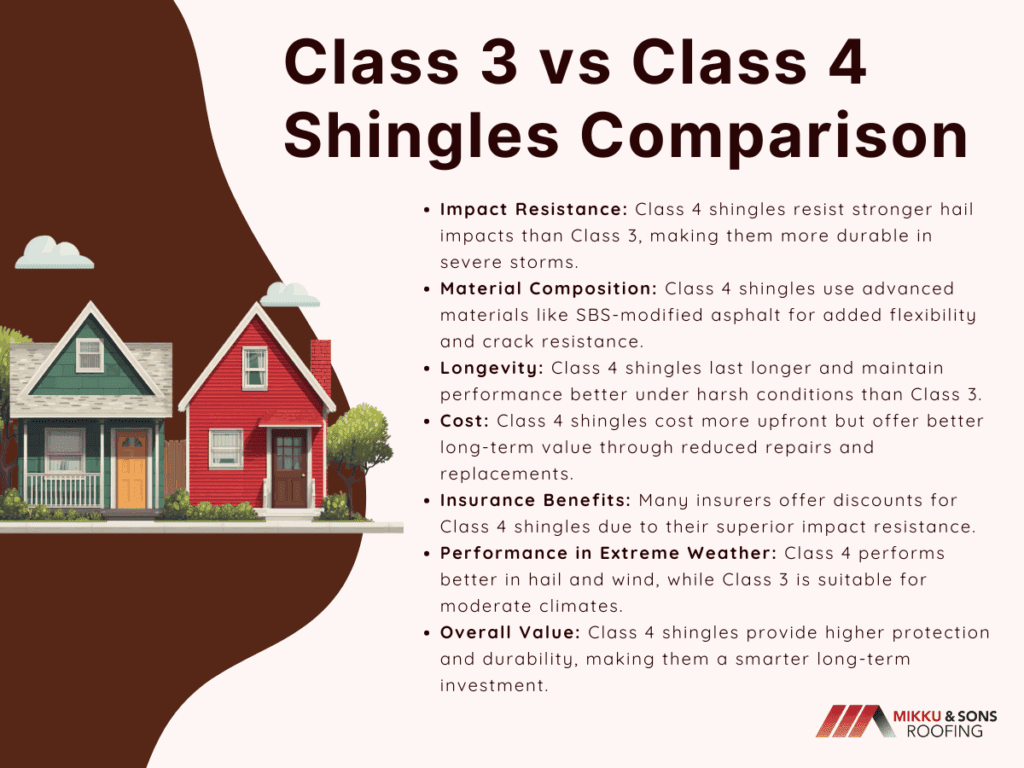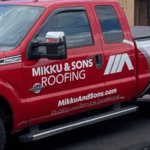

Roofing technology has evolved dramatically, offering homeowners materials engineered for durability, weather resistance, and long-term protection. Among these innovations, impact-rated asphalt shingles have become a key focus for those living in areas exposed to severe storms or hail.
The classification system, developed through Underwriters Laboratories (UL) impact testing, measures a shingle’s ability to withstand hail and debris without cracking. Class 3 and Class 4 shingles represent the highest levels of performance in this testing standard, setting them apart from traditional roofing options.
Investing in higher-rated shingles can influence not only roof lifespan but also insurance costs, energy efficiency, and resale value. For Arizona, Texas, and other hail-prone regions, knowing the difference between Class 3 vs Class 4 shingles helps homeowners make a cost-effective, long-term decision.
Impact ratings were designed to create a consistent way to measure roofing resilience against hail or falling debris. This system allows contractors and homeowners to evaluate materials based on proven physical testing rather than marketing claims.
Each shingle rating, Class 1 through Class 4, is determined by dropping steel balls of various sizes from specific heights to simulate hail damage. Class 3 and Class 4 represent the upper tiers of performance, providing measurable differences in impact resistance and long-term protection.
The UL 2218 impact resistance test is the industry standard used by manufacturers and insurance companies. A Class 3 shingle must resist damage from a 1 3⁄4-inch steel ball dropped from 17 feet, while a Class 4 shingle must remain intact after impact from a 2-inch steel ball at the same height.
Manufacturers submit products for testing to independent laboratories, ensuring that ratings remain consistent and reliable across brands. These tests measure not only surface damage but also whether cracks penetrate through to the shingle’s backing material.
A Class 4 result signifies the shingle sustained no visible cracks or material separation under maximum impact. This rating represents the highest certification available and indicates exceptional durability under severe weather conditions.
Impact resistance focuses on preventing punctures and cracks caused by falling debris, while wind resistance measures a roof’s ability to remain sealed under strong gusts. Although they are separate metrics, both play critical roles in total roof performance.
Class 3 and Class 4 shingles typically offer higher wind ratings because stronger materials are used in their construction. Many Class 4 shingles can resist winds exceeding 130 miles per hour, matching standards required for hurricane zones.
Understanding both metrics helps homeowners evaluate total roof protection, especially in regions with combined threats of wind and hail. Together, these ratings influence overall insurance coverage and potential premium discounts.
Severe weather can cause significant roof damage that leads to leaks, structural deterioration, and costly repairs. Higher impact ratings reduce the likelihood of such issues, offering both peace of mind and financial benefits.
In many cases, insurance providers offer reduced premiums for homes with Class 4 shingles due to their lower risk profile. Over time, these savings can offset part of the installation cost, making the upgrade financially advantageous.

Homeowners who plan to stay in their property for several years typically see long-term returns in reduced maintenance and improved resale appeal. For regions frequently affected by hailstorms, Class 4 protection is often viewed as a necessary investment rather than a luxury.
Class 3 shingles are designed to balance durability and affordability, making them suitable for areas with occasional but not extreme weather events. Their reinforced design offers greater protection than standard shingles while keeping material costs reasonable.
Many homeowners select Class 3 shingles when they seek improved performance without the full investment of premium roofing materials. These shingles often serve as a transitional option between basic and high-end impact-rated roofs.
Class 3 shingles typically feature a fiberglass or asphalt base reinforced with polymer-modified asphalt. This composition allows the material to flex slightly under impact, reducing the chance of surface cracking.
Manufacturers use advanced bonding techniques that enhance granule adhesion, preventing early wear from sun and rain exposure. The result is a more resilient surface that maintains structural integrity longer than conventional shingles.
This moderate impact resistance makes Class 3 shingles effective in regions with mild hail or debris exposure. They provide a practical upgrade for homeowners seeking durability without exceeding mid-range budgets.
The cost of Class 3 shingles generally ranges between $4.00 and $5.50 per square foot, including materials and installation. This range depends on brand, warranty coverage, and regional labor rates.
In terms of lifespan, Class 3 shingles can last between 20 and 30 years, depending on climate and maintenance. Proper attic ventilation and annual inspections can significantly extend their performance life.
For many homeowners, this balance of cost and protection represents a practical middle ground. It delivers strong defense against moderate weather conditions without the premium expense of Class 4 materials.
Some insurers recognize Class 3 shingles under limited hail-resistance programs, though discounts are typically smaller than those offered for Class 4. It’s important for homeowners to verify eligibility before installation.
Manufacturers often provide extended warranties on Class 3 products, but exclusions for severe hail are common. Homeowners should review coverage terms closely to ensure protection aligns with local risk levels.
Discussing options with both roofing contractors and insurance representatives ensures that installation meets certification requirements for potential discounts. Documented proof of product rating is often required to qualify for incentives.
Class 4 shingles represent the highest level of impact resistance available in asphalt roofing materials. These shingles are engineered to endure severe hail and high winds without cracking, granule loss, or material separation.
Their superior construction translates into exceptional longevity and reduced maintenance needs, which are especially valuable in storm-prone regions. For many homeowners, this category offers the greatest long-term return on investment.
Manufacturers reinforce Class 4 shingles using rubberized asphalt compounds that absorb shock and flex on impact. This design allows the shingle to withstand impacts that would typically crack or split lower-rated materials.
Additional layers of fiberglass matting and adhesive sealing improve strength and bonding between shingle layers. These upgrades create a weather-tight surface capable of resisting both impact and wind uplift.
In performance testing, Class 4 shingles maintain structural integrity under impacts equivalent to large hailstones. Their advanced formulation provides a measurable improvement in protection and lifespan over Class 3 counterparts.
Class 4 shingles cost between $5.50 and $8.50 per square foot on average, reflecting the enhanced materials and testing certifications. Installation costs may vary depending on roof complexity and regional labor rates.
Although the upfront expense is higher, many homeowners recover costs through lower insurance premiums and reduced repair frequency. Over a 30-year period, the total cost of ownership often compares favorably with mid-tier options.
Installation requires certified contractors to ensure compliance with UL 2218 standards and warranty terms. Proper ventilation, underlayment, and flashing installation are essential for maintaining performance ratings.
Class 4 shingles frequently qualify for insurance premium reductions, sometimes reaching 20-30 percent in high-risk zones. These savings contribute to faster financial payback after installation.
Their enhanced durability minimizes replacement cycles, saving thousands over decades of homeownership. The material’s resistance to cracking also preserves roof aesthetics, contributing to property value.
For homes exposed to frequent hail, wind, or falling debris, Class 4 shingles deliver unmatched protection. The long-term stability and financial advantages make them a preferred choice among roofing professionals.
Although Class 4 shingles cost more initially, they often deliver measurable financial benefits over time. Reduced maintenance, longer lifespans, and potential insurance discounts improve total value.
Some homeowners view Class 4 roofing as an investment in property protection and resale potential. Real estate listings that highlight impact-resistant materials can attract buyers seeking durability and energy savings.
The initial price of Class 4 shingles can be significantly higher than standard asphalt alternatives, but their enhanced durability reduces long-term expenses. A roof that resists hail, wind, and debris damage needs fewer repairs and lasts longer before replacement becomes necessary.
Homeowners often discover that the cost difference narrows when accounting for reduced maintenance over the roof’s lifespan. Professional installation and proper attic ventilation further enhance performance, protecting against costly structural issues.
Energy efficiency is another overlooked factor in evaluating total value. Class 4 shingles designed with reflective coatings can lower cooling costs, especially in sun-intense regions such as Arizona or Texas.
Many insurers recognize the superior impact resistance of Class 4 shingles and offer premium discounts to homeowners who install them. These savings can offset the higher upfront investment within a few years.
Insurers see lower claim rates from homes protected by impact-resistant roofing, leading to reduced risk and more favorable policy terms. Some states even require insurance providers to publish specific discount structures for Class 4-certified materials.
Before installation, homeowners should confirm that their insurer honors UL 2218 Class 4 certification and request documentation from the roofing contractor. This ensures eligibility for available credits and avoids disputes during claims processing.
Property buyers often view high-grade roofing as a signal of well-maintained, long-lasting construction. A Class 4 roof enhances curb appeal and offers confidence that the home will withstand harsh weather without costly future replacements.
Real estate agents frequently emphasize impact-resistant features when marketing homes in storm-prone regions. Listings that mention Class 4 certification can command stronger offers and shorter time on the market.
Over the long term, homes with resilient roofing systems tend to retain value better than those with lower-grade materials. The combination of energy efficiency, durability, and insurance benefits contributes to a more compelling investment case for buyers and sellers alike.
Class 3 and Class 4 shingles each serve a purpose depending on regional weather patterns, budget considerations, and long-term maintenance goals. Homeowners benefit most when they match their roof’s performance grade to their local environment rather than focusing solely on price.
The decision between these two shingle classes often depends on how a homeowner defines value over time. Those evaluating durability and return on investment can review detailed material and installation costs through how much an asphalt shingle roof costs in Arizona.
For many homeowners, the advantages of Class 4 shingles extend beyond simple protection. Their longer service life, improved insurance incentives, and ability to enhance property resale value make them a sound investment in both comfort and structural security.
